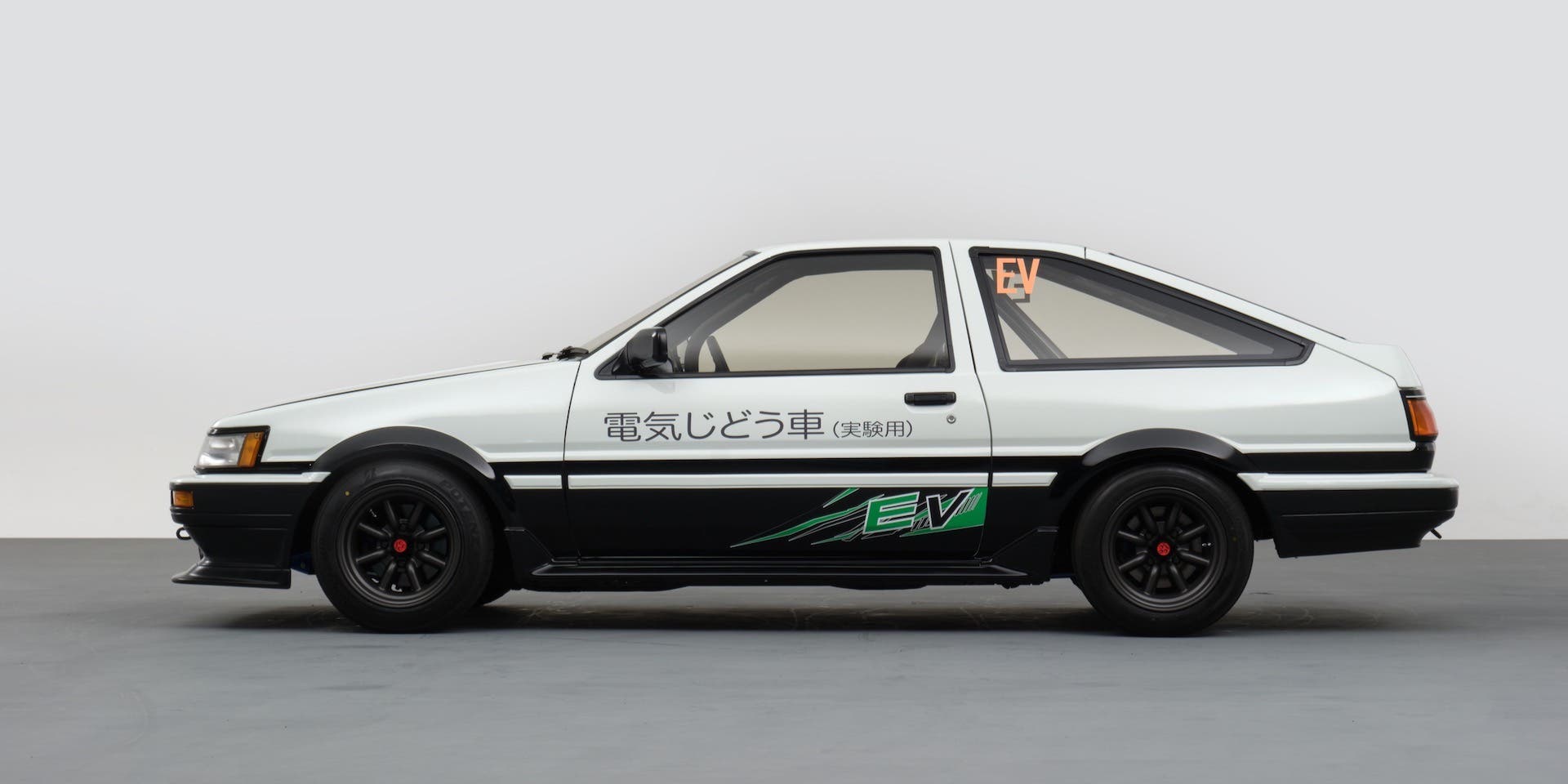Toyota Creates All-Electric Drift Car From Classic “Hachi-roku”
“Carbon neutrality for protecting beloved cars,” Toyota Motor President Akio Toyoda declared as he introduced the Toyota Corolla Levin (AE86) BEV concept to fans at the Tokyo Auto Salon, Japan’s equivalent of the Las Vegas SEMA show.

The Corolla Levin, spelled with the letters “EV” in green, was one of several concept vehicles from Toyota and Lexus at the show, but it was the only pure battery electric vehicle. A second AE86 “Trueno” sported a hydrogen-powered 4A-GE, 4-cylinder engine, revered by small block racing enthusiasts all over the world.
The Levin BEV uses a motor from the Toyota Tundra Hybrid truck and a battery pack from the Prius, but what is interesting is that the engineers kept the clutch and five-speed transmission intact. In a demo drive by Toyota’s test and racing driver Masahiro Sasaki, the BEV showed its wild sideways moves, a lot of tire smoke, and the use of the transmission, which helped the driver modulate the power coming into and out of the tight “S” turns.

“The transmission is really not necessary with an electric motor,” Sasaki said as he explained the vehicle’s technology set-up. “But this car was set up to have the transmission and clutch in order to keep the feel of the car, and the joy of driving such a classic.” The engineering team that designed and built the Levin BEV made sure that only the powertrain was replaced. Everything else about the Levin was retained to ensure that it met Toyoda’s expectation of “leaving no car lovers behind,” which also happens to be Toyota’s theme for the Tokyo Auto Salon 2023.

Engineers retained the AE86’s body, keeping it stripped down to the classic racing seats to keep it lightweight. Rollbars, and racing bucket seats were installed. The front-rear weight balance was maintained, by placing the motor very low but forward in the engine bay with a connecting transmission and the Prius PHEV battery pack spread throughout the vehicle floor — thus, a 53:47 bias was achieved, the kind of ratio needed for a rear wheel drive vehicle.
Toyota engineers also pointed out that as much as possible, “the robust driving force” characteristic of the car was maintained, but posed challenging because of the extremely linear power delivery by the electric motor. To connect the electric motor to the 5-speed manual transmission with a clutch also meant the use of sensors to match motor speeds during shifting. Since it is a rear-wheel-drive car, the rear differential is essential unmodified.

“Making vintage cars driveable in the age of carbon neutrality is a wonderful idea. To have old cars get back to life or remain on the roads powered by hydrogen or electricity is great,” Buboy Roño, a Filipino car mechanic working in Yokohama, told CleanTechnica.
“There is so much to look forward to when the aftermarket starts grasping what they can do with electric powered cars,” Hoshiro Nakanishi, a local journalist and EV enthusiast, said, pointing out how Japan is focused more on hybrid powertrains and all electric systems. “Hybrid is so successful here in Japan, we forgot about battery electric all together. In Japan, restoring, preserving and keeping classic cars running is expensive and very hard work. Conversions might be a good option.”
Companies like UK-based EV-upcycler Lunaz are looking to Japan as a strong market for conversion. There are many well preserved vintage British luxury cars, like Aston Martins and Rolls Royces, which are best for electrification.
“Morizo,” the racing pseudonym of Toyota’s president Toyoda, said that both the BEV and the hydrogen versions were made to “give greater driving pleasure than the original.” These technologies may be offered on the Toyota aftermarket for car enthusiasts.
Toyoda explained that though other companies have set full battery electrification of their vehicles between 2030 and 2050, he believes that it will take time for all new vehicles to become carbon neutral — a stance that Toyota Motor has taken from the very start, which is why it focused on development of hybrid and plug-in hybrid systems, unlike Nissan, which went on full electric.
“By simultaneously promoting the carbon neutralization of not only new vehicles but also of vehicles currently in customer use is essential for the future, we can ensure the joy of driving cherished classic cars is not lost in the age of carbon neutrality,” Toyoda mentioned.
Previously under the TRD (Toyota Racing Development) banner and now with the Toyota-Gazoo Racing (GR) marque, Toyota participates in the Tokyo Auto Salon to showcase mostly their aftermarket offerings. Under the three concepts of “carbon neutrality for protecting beloved cars,” “making ever-better motorsports-bred cars,” and “diverse lifestyles to enjoy with beloved cars,” TGR and luxury brand Lexus introduced new ways to enjoy cars and motorsports in the carbon-neutral era.
There were several sessions at the show where GR engineers, professional racing drivers, and development specialists discussed the many possibilities of conversion. The fun part was at the back of the Makuhari Messe Convention Center, where demo runs were conducted.
Have a tip for CleanTechnica? Want to advertise? Want to suggest a guest for our CleanTech Talk podcast? Contact us here.
Latest CleanTechnica.TV Video

CleanTechnica uses affiliate links. See our policy here.

